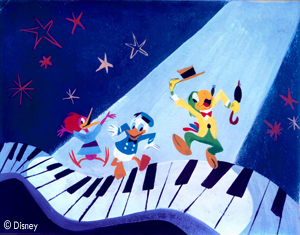Much of animation is simply a matter of doing a job as it should be done. Maybe a scene is no more than a funny walk or a brief dance step. An animator's responsibility is to interpret a track, picking it apart mentally and then making his animation interpret each innuendo, each nuance with drawings that hopefully add life to a scene—even beyond the scope of the soundtrack.
An important part of a track is musical. The music beat is vital to the artist. On an animator's work sheet, usually referred to as an Exposure Sheet, music beats are indicated in actual film frames. An eight (8) beat would be eight frames of film; a twelve (12) beat, twelve frames of film. It is natural to assume that an artist's plan would be to carefully accent each musical beat, however, astute animators avoid anything so mundane.
A musical beat is a marvelous thing. An animator can split it in the middle, avoid it completely, or even divide it into three or four parts as a musical composer often does. A musical beat is the skeleton on which an animator builds the muscle of his action. He can plan an accent to happen before, behind or right on a beat, according to how he desires to psyche his audience.
Art Babbitt, the suave and talented savant of Animation's Golden Years, has a tantalizing way of reaching an accent a twelfth of a second late. It reminds one of a magician catching a coin or a playing card in midair at the very instant you are sure he will not get it. It is maddening, but it is good entertainment.
An experienced animator has many strings on his bow. Milt Kahl, recently retired Zeus among animators, picks up a beat with the adeptness of Sherlock Holmes pinpointing an important clue in a murder plot. To Frank Thomas, an artist with unusual musical skills, the reading of a beat came naturally and tastefully. He accomplished it with the sang froid of a fastidious gourmet putting just the proper touch of Escoffier sauce to a serving of chilled oysters. Every beat has its special character—its special importance.
Freddy Moore had a slam-bang manner of animating rough-shod through one beat, then picking up the next beat with the caution one might use in picking up a live rattlesnake. Norm Ferguson, master of all of the elements of animation, could carry three characters through a syncopated sound track and put the right emphasis on each beat so neatly that no one could ever quite tell how it happened. His exposure sheets were more complicated than the musical score for Beethoven's 9th Symphony.
Bill Tytla was a glittering star among animators, a modern Pieter Brueghel working with living pawns, a wild cossack riding a loco horse over the steppes of the Ukraine. He was a wizard at searching out beats—a fantastic planner and plotter. Sometimes a beat is hidden away in a pile of trashy sound effects, but it is still worth searching for. Bill always found and used a hidden beat. It added a touch of Tabasco to his animation.
Too often a novice hopes to accent a beat with exaggerated mouth action. Mouths can be funny, but they do little to help an accent—even with funny dialogue. A body accent, a dramatic posture, is The Thing—always. An animator may have a track that is only dialogue or recorded sound. Lacking a musical beat with which to work, he must choose from the track accents on which he can structure his animation.
--Thus wrote master animator Grim Natwick, of Betty Boop and Snow White fame, on January 6th, 1978, in an article or chapter called "Reading Sound." It is not known to me what he wrote this for, but I find it very interesting and in line with my previous postings on
beats and barsheets. If you have not yet read these, I invite you to do so, as "animation to a musical beat" has been undervalued for much to long, especially among CG artists who wrongly consider any technique applied to hand-drawn animation to be too old-fashioned or just inapplicable to the CG medium. In the past century, many wonderful artists have pioneered the medium of entertainment through animation, and it would be a crying shame not to at least take notice of their advancements!
Labels: Barsheets, Beatronome, Other Disney































